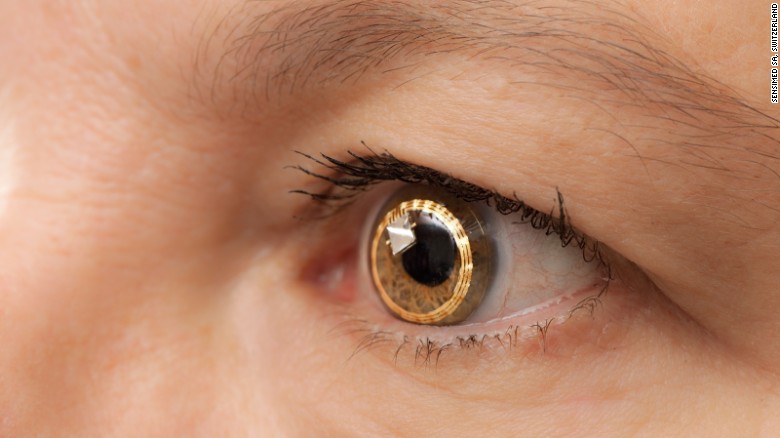
(CNN)Lights, mirrors, action! Scientists are developing smart contact lenses embedded with miniscule mirrors that can magnify your vision by almost three times.
The 1.55mm-thick
lenses incorporate a thin reflective telescope made of mirrors and
filters; when light enters the eye it bounces off the series of mirrors
and increases the perceived view of an object or person. It is hoped
that the lens will improve the sight of people with age-related macular
degeneration (AMD) -- the third leading cause of blindness globally.
AMD
causes the loss of central vision due to gradual damage to the eye's
retina and there are few options for cure or treatment. "AMD is the
biggest problem where magnification is a proven visual aid," says Eric
Tremblay, research scientist at EPFL in Switzerland.
Tremblay led the optical design of the lens, which is based on a surgically implantable telescope
currently used by some patients with AMD, but which is more invasive
than a lens. "With a contact lens, it's easy to try it," says Tremblay.
Making the switch
A
key innovation with the lenses is the added ability to switch between
magnified and regular vision through a complementary pair of glasses.
The battery-powered glasses use LCD technology to watch the movement of
the eye and a simple wink can alter their polarization and determine
whether light entering is magnified or not. "Having the ability to
switch on demand is attractive," says Tremblay.
The
ability to selectively magnify your vision makes the design of the
glass-lens combination more suitable for daily life. "When magnified you
lose a lot of your field of view, your peripheral vision," says
Tremblay. A strategic wink will enable users to keep an eye on their
periphery, such as cars approaching them as they cross a street, whilst
also being able to zoom in and recognize the faces of those around them.
The
team developed their technology on scleral lenses, which have an
increased thickness and diameter, making them commonly used for more
special purpose eye care. "[They provide] a lot more area to work with,"
says Tremblay. The challenge these lenses bring with them, however, is
comfort, as they impede the amount of oxygen reaching the eye.
The
most recent prototype, unveiled by the team in February, overcame this
challenge by introducing air channels to aid the flow of oxygen to the
eye. But the team hopes to improve this further still by instead
developing a contact lens solution saturated with oxygen which can be
stored and slowly released into the eye. "[We will] build reservoirs
into the back of the lens," says Tremblay.
The
lenses have only been trialled on a handful of humans to test for
comfort, with the majority of research to date performed in the lab
using a model chemical eye. But more human trials are on the cards with
the eventual goal of daily wearable contacts to aid the visually
impaired.
"We want it to move in the direction of a real world vision aid," says Tremblay.
Getting smarter
These
are not the first smart contact lenses. Other prototypes have been
developed to monitor, as well as improve, health in both the eye and
across the body.
Alcon, the eye care
division of Novartis, formed a partnership with Google X in 2014 to
develop smart-lens technologies for a range of medical eye care
applications. One of the first examples of using lenses in this form was
Sensimed,
a spin-off also emerging from EPFL. Sensimed's Triggerfish technology
monitors the progression of glaucoma -- the second leading cause of
blindness, affecting more than 4.5 million people globally.
Glaucoma
is a progressive cause of blindness caused by deterioration of the
eye's optic nerve. The traditional test used by optometrists to monitor
patients uses puffs of air to measure pressure in the eye but such
measurements are not ideal.
"The big
need in glaucoma is for a 24-hour picture of what's happening inside the
eye," says David Bailey, CEO of Sensimed. Its smart lens uses strain
gauges and sensors embedded inside a chip located in the lens to measure
changes in the volume of liquid in the eye as a surrogate measurement
of pressure. It can be worn over a 24-hour period to monitor pressure
patterns and communicate data wirelessly to a recording device worn
around the user's neck.
Optometrist James Wolffsohn, spokesperson for the British Contact Lens Association,
looks forward to one day using technologies like the telescopic lens in
clinical practice. "The lens seems an interesting concept to provide
optical magnification to the retina when required," he says. But he adds
that there will be challenges in reaching that stage: "It is currently a
scleral lens and thick, including rigid mirror elements which are
likely to affect corneal physiology and comfort." Wolffsohn has seen
colleagues trial the more established Triggerfish technology to monitor
glaucoma and is optimistic about the future of the field. "There are
also many other exciting developments in innovative uses of contact
lenses," he says.
"The eye is the
window to many disease states," says Bailey, who believes contact lenses
are the future for eye care, both in terms of clinical use and
lifestyle management. More than 30 million people wear contact lenses in
the United States alone, according to the Centers for Disease Control,
which means they could be a non-invasive path to health management -- be
it blindness progression or even insulin or alcohol level monitoring.
"Eye-sensing on contact lenses is here to stay ... in one form or another," says Bailey.
No comments:
Post a Comment